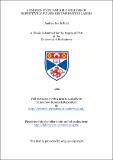Files in this item
A unified state variable analysis of repetitively pulsed recombination lasers
Item metadata
| dc.contributor.advisor | Maitland, Arthur | |
| dc.contributor.author | Kidd, Andrew Keith | |
| dc.coverage.spatial | 2 v (505p). | en_US |
| dc.date.accessioned | 2018-06-20T10:32:55Z | |
| dc.date.available | 2018-06-20T10:32:55Z | |
| dc.date.issued | 1992-07 | |
| dc.identifier.uri | https://hdl.handle.net/10023/14320 | |
| dc.description.abstract | A unified state-space model of a high repetition rate electrical discharge in a helium-strontium mixture is presented. The atomic (number density of particles in a particular state), optical (number density of photons), thermodynamic (local particle temperature and pressure) and electrical (voltage and current) internal states of the system are the state variables. A generalised circuit analysis program (GCAP) provides a description of the excitation circuit used to power the strontium laser. Rate equations describing the time evolution of the state variables are simultaneously numerically integrated to provide a description of the laser system during the discharge of a capacitor through the laser load and in the immediate afterglow. The effects of parametric variation of the circuit on strontium laser performance are examined. The model predicts that Sr++ ions are formed during the discharge current pulse by step-wise excitation from SrII states lying lower in energy. A population inversion is achieved on the 62S1/2-52P3/2 transition in SrII (lambda=430.5nm) in the current pulse afterglow by rapid three-body recombination of Sr++ ions. A strong recombination flux is established on rapid termination of the discharge current pulse. Impedance matching of excitation circuit to load is essential for stimulated emission under recombination conditions. The results of the state variable analysis are validated by experiment. The operating characteristics of a discharge-heated strontium vapour laser are presented. An average power of 0.3W is obtained in a high heat-loss configuration. The fall-time of the discharge current pulse is reduced by means of a saturable inductor placed in parallel with the laser load. The circuit generates current pulses with peak amplitudes up to 300A and fall-times of less than 70ns. GCAP is used to estimate the theoretical limits on the fall-time of the laser current by state variable analysis of a flux-controlled model of the saturable inductor. | en_US |
| dc.language.iso | en | en_US |
| dc.publisher | University of St Andrews | |
| dc.subject.lcc | TK7872.L3K5 | |
| dc.subject.lcsh | Lasers | |
| dc.title | A unified state variable analysis of repetitively pulsed recombination lasers | en_US |
| dc.type | Thesis | en_US |
| dc.contributor.sponsor | EEV ltd. | en_US |
| dc.type.qualificationlevel | Doctoral | en_US |
| dc.type.qualificationname | PhD Doctor of Philosophy | en_US |
| dc.publisher.institution | The University of St Andrews | en_US |
This item appears in the following Collection(s)
Items in the St Andrews Research Repository are protected by copyright, with all rights reserved, unless otherwise indicated.

